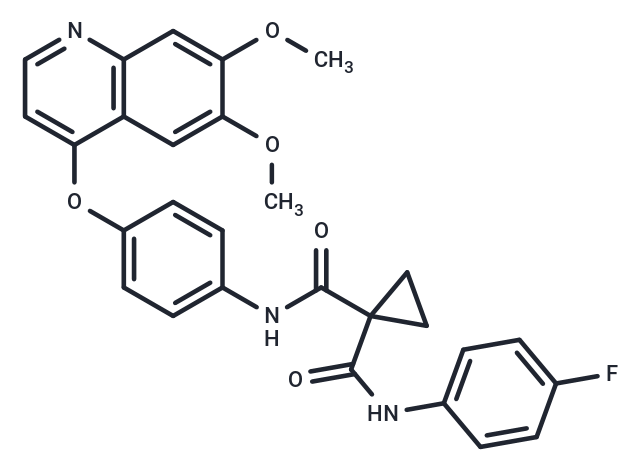购物车
- 全部删除
 您的购物车当前为空
您的购物车当前为空

Cabozantinib (XL184) 是一种多靶点酪氨酸激酶受体抑制剂,可以抑制 VEGFR2、c-Met、Kit、Axl 和 Flt3 (IC50=0.035/1.3/4.6/7/11.3 nM)。Cabozantinib 具有抗肿瘤和抗血管生成活性。

Cabozantinib (XL184) 是一种多靶点酪氨酸激酶受体抑制剂,可以抑制 VEGFR2、c-Met、Kit、Axl 和 Flt3 (IC50=0.035/1.3/4.6/7/11.3 nM)。Cabozantinib 具有抗肿瘤和抗血管生成活性。
| 规格 | 价格 | 库存 | 数量 |
|---|---|---|---|
| 1 mg | ¥ 276 | 现货 | |
| 2 mg | ¥ 393 | 现货 | |
| 5 mg | ¥ 635 | 现货 | |
| 10 mg | ¥ 898 | 现货 | |
| 25 mg | ¥ 1,550 | 现货 | |
| 50 mg | ¥ 2,370 | 现货 | |
| 100 mg | ¥ 3,320 | 现货 | |
| 200 mg | ¥ 4,530 | 现货 | |
| 500 mg | ¥ 6,560 | 现货 | |
| 1 mL x 10 mM (in DMSO) | ¥ 713 | 现货 |
| 产品描述 | Cabozantinib (XL184) is a multi-targeted tyrosine kinase receptor inhibitor that inhibits VEGFR2, c-Met, Kit, Axl, and Flt3 (IC50=0.035/1.3/4.6/7/11.3 nM). Cabozantinib exhibits both antitumor and antiangiogenic activity. |
| 靶点活性 | VEGFR2:0.035 nM (cell free), RET:5.2 nM (cell free), Axl:7 nM (cell free), MET (Y1248H):3.8 nM (cell free), MET:1.3 nM (cell free), FLT3:11.3 nM (cell free) |
| 体外活性 | 方法:前列腺癌细胞 LNCaP、C4-2B 和 PC-3 用 Cabozantinib (0.01-5 µM) 处理 72 h,使用 WST-1 Assay 检测细胞活力。 结果:Cabozantinib 以剂量依赖的方式抑制 LNCaP、C4-2B 和 PC-3 细胞系的细胞活力。[1] 方法:人肾癌细胞 786-O 和 A498 用 Cabozantinib (10-100 nM) 处理 1 h,随后用 HGF (1 nM) 刺激 20 min,使用 Western Blot 检测靶点蛋白表达水平。 结果:10 nM Cabozantinib 处理抑制了 HGF 激活的 pMET、pAKT、pERK 和 p-mTOR。[2] |
| 体内活性 | 方法:为检测体内抗肿瘤活性,将 Cabozantinib (60 mg/kg) 口服给药给胫骨内注射前列腺癌细胞 Ace-1 的 SCID 小鼠,每天一次,持续五周。 结果:Cabozantinib 抑制 Ace-1 细胞在体内的进展。[1] 方法:为检测体内抗肿瘤活性,将 Cabozantinib (1-60 mg/kg) 口服给药给携带肿瘤 MDA-MB-231、H441 或 C6 的 nu/nu 小鼠,每天一次,持续 12-14 天。 结果:Cabozantinib 以剂量依赖的方式抑制肿瘤生长。[3] |
| 激酶实验 | The inhibition profile of cabozantinib against a broad panel of 270 human kinases was determined using luciferase-coupled chemiluminescence, 33P-phosphoryl transfer, or AlphaScreen technology. Recombinant human full-length, glutathione S-transferase tag or histidine tag fusion proteins were used, and half maximal inhibitory concentration (IC50) values were determined by measuring phosphorylation of peptide substrate poly(Glu, Tyr) at ATP concentrations at or below the Km for each respective kinase. The mechanism of kinase inhibition was evaluated using the AlphaScreen Assay by determining the IC50 values over a range of ATP concentrations [1]. |
| 细胞实验 | Receptor phosphorylation of MET, VEGFR2, AXL, FLT3, and KIT were, respectively, assessed in PC3, HUVEC, MDA-MB-231, FLT3-transfected BaF3, and KIT-transfected MDA-MB-231 cells. Cells were serum starved for 3 to 24 hours, then incubated for 1 to 3 hours in serum-free medium with serially diluted cabozantinib before 10-minute stimulation with ligand: HGF (100 ng/mL), VEGF (20 ng/mL), SCF (100 ng/mL), or ANG1 (300 ng/mL). Receptor phosphorylation was determined either by ELISA using specific capture antibodies and quantitation of total phosphotyrosine or immunoprecipitation and Western blotting with specific antibodies and quantitation of total phosphotyrosine. Total protein served as loading controls [1]. |
| 动物实验 | Female nu/nu mice were housed according to the Exelixis Institutional Animal Care and Use Committee guidelines. H441 cells (3 × 10^6) were implanted intradermally into the hind flank and when tumors reached approximately 150 mg, tumor weight was calculated using the formula: (tumor volume = length (mm) × width^2 (mm^2)]/2, mice were randomized (n = 5 per group) and orally administered a single 100 mg/kg dose of cabozantinib or vehicle. Tumors were collected at the indicated time points. Pooled tumor lysates were subjected to immunoprecipitation with anti-MET and Western blotting with anti-phosphotyrosine MET. After blot stripping, total MET was quantitated as a loading control. In a separate experiment, naive mice (n = 5 per group) were administered a single 100 mg/kg dose of cabozantinib or vehicle, followed by intravenous administration of HGF (10 μg per mouse) 10 minutes before liver collection. Analysis of MET phosphorylation in liver lysates was as described above. In a separate experiment, naive mice (n = 5 per group) were administered a single 100 mg/kg dose of cabozantinib or vehicle, followed by intravenous administration of VEGF (10 μg per mouse) 30 minutes before lung collection. Pooled lung lysates were subjected to immunoprecipitation with FLK1 and Western blotting with anti-phosphotyrosine. After blot stripping, total FLK1 was quantitated as a loading control [1]. |
| 别名 | 卡博替尼, XL184, BMS-907351 |
| 分子量 | 501.51 |
| 分子式 | C28H24FN3O5 |
| CAS No. | 849217-68-1 |
| Smiles | C(NC1=CC=C(OC=2C3=C(C=C(OC)C(OC)=C3)N=CC2)C=C1)(=O)C4(C(NC5=CC=C(F)C=C5)=O)CC4 |
| 密度 | 1.397 g/cm3 |
| 存储 | Powder: -20°C for 3 years | In solvent: -80°C for 1 year | Shipping with blue ice. | ||||||||||||||||||||||||||||||
| 溶解度信息 | H2O: < 1 mg/mL (insoluble or slightly soluble) DMSO: 50 mg/mL (99.7 mM), Sonication is recommended. Ethanol: < 1 mg/mL (insoluble or slightly soluble) | ||||||||||||||||||||||||||||||
| 体内实验配方 | 10% DMSO+40% PEG300+5% Tween 80+45% Saline: 9.3 mg/mL (18.54 mM), Suspension. 请按顺序添加溶剂,在添加下一种溶剂之前,尽可能使溶液澄清。如有必要,可通过加热、超声、涡旋处理进行溶解。工作液建议现配现用。以上配方仅供参考,体内配方并不是绝对的,请根据不同情况进行调整。 | ||||||||||||||||||||||||||||||
溶液配制表 | |||||||||||||||||||||||||||||||
DMSO
| |||||||||||||||||||||||||||||||
评论内容